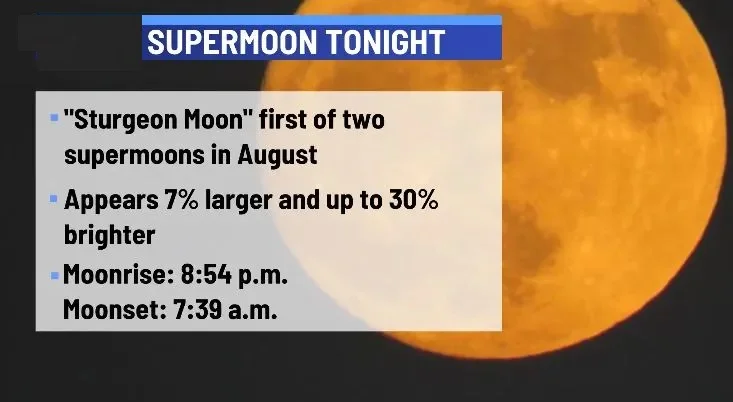
Introduction
Central Texas is gearing up to witness the first of two spectacular supermoons this August. This celestial event, known as the “Sturgeon Moon,” promises to deliver a breathtaking display as the moon graces our skies, appearing larger and brighter than usual. So, how can you make the most of this extraordinary occurrence? In this article, we’ll guide you through the process of viewing tonight’s supermoon and provide you with all the essential details you need to know.
Understanding the Supermoon Phenomenon
Before we dive into the specifics of how to view the supermoon, let’s take a moment to understand what makes this celestial event so special. A supermoon occurs when the full moon coincides with its closest approach to Earth, known as the perigee. This unique alignment results in a moon that appears not only larger but also up to 30% brighter in the night sky. In 2023, we are fortunate to witness four supermoons, and the “Sturgeon Moon” is the one gracing our skies tonight.
Unveiling the “Sturgeon Moon”
The intriguing name “Sturgeon Moon” finds its origins in the Great Lakes region, where large fish, namely sturgeons, were historically more abundant and easily caught during this time of the year. However, this supermoon is known by various other names, such as the Red Moon, the Corn or Green Corn Moon, the Barley Moon, the Herb Moon, the Grain Moon, and even the Dog Moon. Each name reflects the unique cultural and natural aspects of this captivating lunar event.
Mark Your Calendar: The Blue Moon of Aug 30
As August unfolds, the celestial show continues. Following the “Sturgeon Moon,” keep an eye out for the upcoming Blue Moon on August 30th. This second supermoon of the month is a rare occurrence, adding to the celestial wonder and giving sky enthusiasts yet another reason to marvel at the night sky.
Timing and Sky Conditions
Now that you’re eager to witness the “Sturgeon Moon” in all its glory, let’s talk about when and where to look. In Austin, the moon is set to rise on the eastern horizon at 8:54 p.m. As the night progresses, the skies are expected to remain mostly clear, providing an excellent opportunity to view the moon through its journey across the night sky. The moonset will occur on the western horizon at 7:39 a.m. the following morning, allowing for an extended period of observation.
Grab Your Binoculars and Cameras
While the naked eye will undoubtedly provide a remarkable view of the supermoon, why not enhance the experience further? Grab a pair of binoculars or a camera with a telephoto lens to capture the intricate details of the moon’s surface. The enhanced magnification can reveal a myriad of fascinating features, from craters and lunar seas to the subtle play of light and shadow.
Conclusion
As the night falls and the “Sturgeon Moon” graces our skies, take a moment to connect with the celestial wonders that surround us. The awe-inspiring beauty of a supermoon serves as a reminder of the marvels of our universe, igniting a sense of wonder and curiosity within us. Whether you’re an experienced skywatcher or new to the world of stargazing, the “Sturgeon Moon” presents an opportunity to appreciate the cosmos in all its splendor.
FAQs
1. When is the “Sturgeon Moon” visible? The “Sturgeon Moon” will be visible from Central Texas on the night of August 1st into the morning of August 2nd.
2. Why is it called the “Sturgeon Moon”? The name originates from the Great Lakes region, where sturgeon fish were more easily caught during this season.
3. Can I view the supermoon with the naked eye? Absolutely! The supermoon’s brilliance is visible to the naked eye, but using binoculars or a camera can provide a more detailed view.
4. What other names is the supermoon known by? The supermoon goes by various names, including the Red Moon, Corn Moon, Green Corn Moon, Barley Moon, Herb Moon, Grain Moon, and Dog Moon.
5. When is the next supermoon after the “Sturgeon Moon”? The next supermoon, known as the Blue Moon, will be visible on August 30th.




